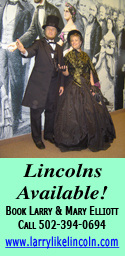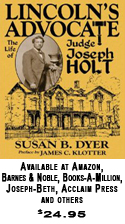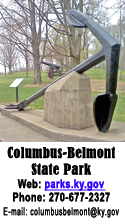|
Confederate Major Joel Mayo Womack
was key organizer of Kentucky Derby
By BRYAN BUSH
Bugle Staff Writer
Joel Mayo Womack is a name to remember where the Kentucky Derby is concerned. A major in the Confederate army, he was one of the organizers of the Louisville Jockey Club and was secretary when Churchill Downs was built in 1875.
Then, along with close friend Meriwether Lewis Clark, he assisted Clark in establishing the Kentucky Derby.
But this Louisiana native had a colorful Civil War career before he made his way to Louisville in 1870.
Womack was born Feb. 3, 1845 in New Orleans and was a cadet at the South Carolina Military Academy also known as the Citadel. He was detailed as a drillmaster at Camp Butler, near Aiken, S.C., and helped train the 14th South Carolina Infantry.
When the Civil War broke out, he enlisted in Capt. Moses B. Humphrey’s Company of Cadet Rangers, and later was with 16th Battalion of South Carolina Partisan Rangers, which later became Company F, 6th South Carolina Cavalry.
On June 9, 1862, he transferred to Company D, 5th South Carolina Cavalry, and, on Jan. 3, 1863, to the 5th South Carolina Cavalry Regiment commanded by Lt. Col. Samuel W. Ferguson.
The 5th South Carolina served as detached commands and was assigned to coast defenses at various locations in the Carolinas until March 1864. In March, the War Department ordered the 5th South Carolina to Virginia where the regiment assembled in April, and along with the 4th and 6th S.C. Cavalry regiments, formed Butler’s Brigade, Hampton’s Division, Cavalry Corps, Army of Northern Virginia.
For the remainder of the year, the regiment was actively engaged as mounted infantry in various actions associated with the defense of Richmond and Petersburg and the vital railroad lines supplying the Army of Northern Virginia.
On June 20, 1864, Womack was captured at White House near Louisa Court House, Va., and send to Point Lookout, Md. On July 25, he was transferred to the prisoner of war camp at Elmira, N.Y., where, by the end of August, there were 10,000 enlisted Confederate prisoners. Living conditions were deplorable since the barracks held only half the prisoners with the other half living in tents, even in the harsh New York winters.
There also was a serious sanitation problem. The sinks drained into a pond that stretched the length of the prison. The 40-acre camp was located below the level of the Chemung River, making drainage of the pond difficult if not impossible. The prison also lacked vegetables and the prisoner soon came down with scurvy. By Nov. 1, 775 prisoners died from the disease.
Womack had enough of the conditions at Elmira and on Oct. 27 he decided to forge commandant Major Henry Colt’s name to a pass that he found in a book in the prison library. He presented the pass to the guards who examined it and he walked out of the front gate. Womack wrote that “the farther I got away, the faster I walked.” He was the 11th person to escape Elmira. On Oct. 7, 1864, 10 other prisoners had managed to dig a tunnel 66-feet long under the stockade perimeter and escape.
Making his way back to Richmond, Va., Womack rejoined his company. In January 1865, the 5th South Carolina was reassigned to Wheeler’s Cavalry Corps, Army of Tennessee and returned to Columbia, S.C., to check the advance of Major Gen. William T. Sherman’s Union troops from Georgia. The 5th Carolina was involved in continuous skirmishing with numerically superior Federal forces as they moved north from Columbia to northeastern South Carolina and finally into central North Carolina.
The 5th South Carolina participated in the final battle of the Carolinas Campaign at Bentonville and provided escort to Confederate Gen. Joseph Johnston when he met to discuss surrender terms with Gen. Sherman on April 17, 1865. On April 27, the regiment, along with Womack, surrendered at Hillsboro, N.C.
Womack was a clerk in Charleston, S.C., before moving to Louisville and becoming involved in Churchill Downs. Under Gov. Augustus Willson (36th Governor of Kentucky, 1907-1911), Womack was appointed commissioner of Confederate records and later became an insurance salesman.
He died June 14, 1921, and is buried in Louisville’s Cave Hill Cemetery near such notables as Confederate Gen. William Lowther Jackson.
|












